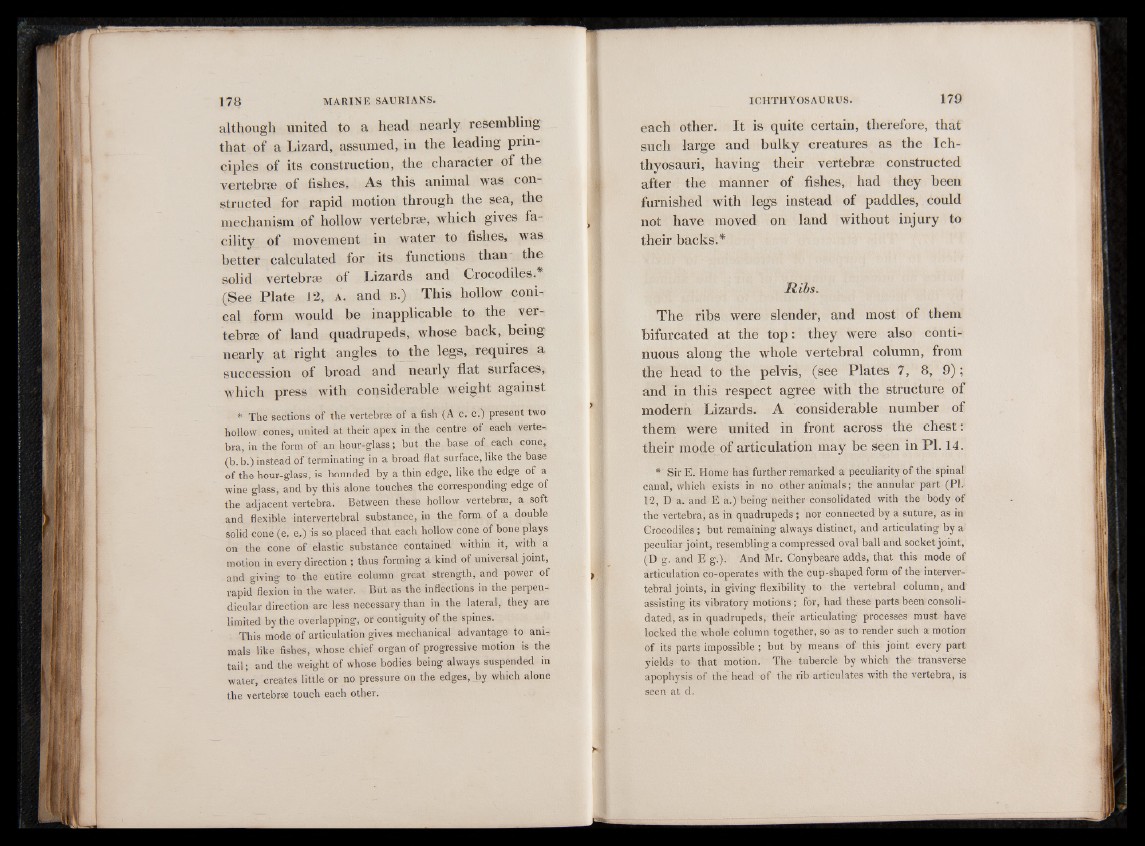
although united to a head nearly resembling
that of a Lizard, assumed, in the leading principles
of its construction, the character of the
vertebra} of fishes, As this animal was constructed
for rapid motion through the sea, the
mechanism of hollow vertebrae, which gives facility
of movement in water to fishes, was
better calculated for its functions than the
solid vertebrae of Lizards and Crocodiles.
(See Plate 12, a. and b.) This hollow conical
form would be inapplicable to the vertebrae
of land quadrupeds, whose back, being
nearly at right angles to the legs, requires a
succession of broad and nearly flat surfaces,
which press with considerable weight against
* The sections of the vertebrae of a fish (A c. c.) present two
hollow cones, united at their apex in the centre of each verte-,
bra, in the form of an hour-glass; but the base of each cone,
(b. b.) instead of terminating in a broad flat surface, like the base
of the hour-glass, is bounded by a thin edge, like the edge of a
wine glass, and by this alone touches the corresponding edge of
the adjacent vertebra. Between these hollow vertebrae, a soft
and flexible intervertebral substance, in the form of a double
solid cone (e. e,) is so placed that each hollow cone of bone plays
on the cone of elastic substance contained within it, with a
motion in every direction ; thus forming a kind of universal joint,
and giving to the entire column great strength, and power of
rapid flexion in the water. But as the inflections in the perpendicular
direction are less necessary than in the lateral, they are
limited by the overlapping, or contiguity of the spines.
This mode of articulation gives mechanical advantage to animals
like fishes, whose chief organ of progressive motion is the
tail; and the weight of whose bodies being always suspended in
water, creates little or no pressure on the edges, by which alone
the vertebrae touch each other.
each other. It is quite certain, therefore, that
such large and bulky creatures as the Ichthyosauri,
having their vertebrae constructed
after the manner of fishes, had they been
furnished with legs instead of paddles, could
not have moved on land without injury to
their backs.*
Ribs.
The ribs were slender, and most of them
bifurcated at the top: they were also continuous
along the whole vertebral column, from
the head to the pelvis, (see Plates 7, 8, 9);
and in this respect agree with the structure of
modern Lizards. A considerable number of
them were united in front across the chest :
their mode of articulation may be seen in PI. 14.
* Sir E. Home has further remarked a peculiarity of the spinal
canal, which exists in no other animals; the annular part (PI.
12, D a. and E a.) being neither consolidated with the body of
the vertebra, as in quadrupeds; nor connected by a suture, as in
Crocodiles ; but remaining always distinct, and articulating by a
peculiar joint, resembling a compressed oval ball and socket joint,
(D g. and E g.). And Mr. Conybeare adds, that this mode of
articulation co-operates with the cup-shaped form of the intervertebral
joints, m giving flexibility to the vertebral column, and
assisting its vibratory motions; for, had these parts been consolidated,
as in quadrupeds, their articulating processes must have
locked the whole column together, so as to render such a motion
of its parts impossible ; but by means of this joint every part
yields to that motion. The tubercle by which the transverse
apophysis of the head of the rib articulates with the vertebra, is
seen at d.